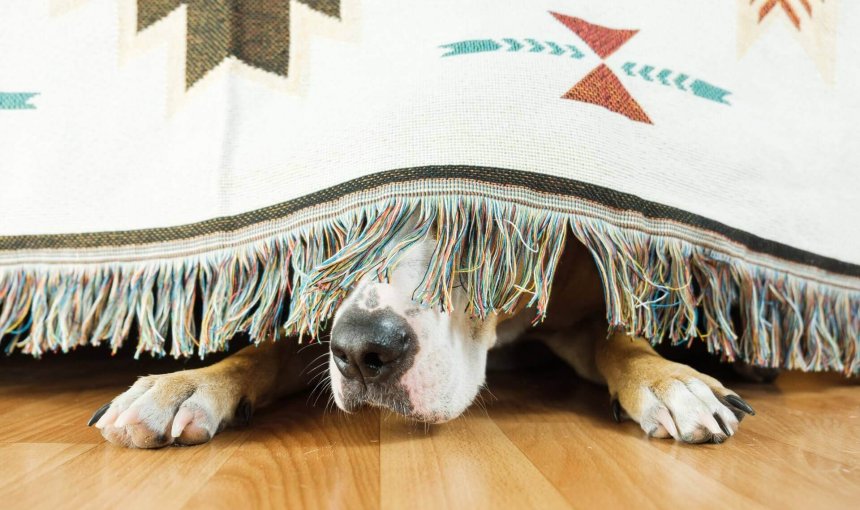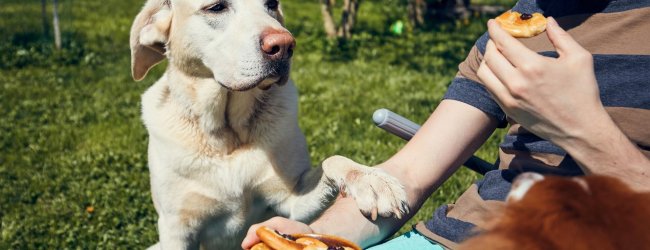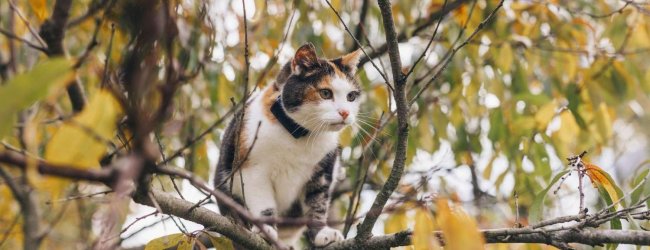Noise Anxiety In Dogs: Prevent Your Buddy From Spooking
Does your buddy run away at the slightest sound - not just fireworks but maybe also your hairdryer or a passing garbage truck? Turns out, noise anxiety in dogs can end up with some destructive behavior if left unattended, including runaway attempts. So here's how to manage it - for good.

Loud noises can startle any dog, but some dogs might spook a little extra when they hear thunder, fireworks, car alarms, and other sounds. This is known as noise aversion, noise sensitivity or noise anxiety in dogs. It’s a relatively common phenomenon – affecting at least one third of all dogs in the US.
So in this post, we’re going to share some of our top tips on how to manage your buddy’s noise anxiety – and how to plan ahead for an emergency, in case they do spook and run off at a loud sound. Let’s get started.
Key Takeaways
Noise anxiety is a common condition
Dogs can have intense reactions to loud or sudden noises like thunderstorms and fireworks, and this can turn up as mild startling or severe phobias.
Symptoms and causes
Symptoms can include trembling, hiding, and even destructive or runaway behavior. The anxiety can be caused by learned behaviors, lack of socialization, past trauma, or even underlying pain.
How to manage it
You can help a dog with noise anxiety by creating a safe space for them, using calming noises, distracting them with toys, and through counter-conditioning. This involves gradually desensitizing the dog to the sound.
The Tractive smart dog tracker can help prevent an emergency
Your Tractive devices includes Bark Monitoring that detects excessive barking due to stress. Its GPS functionality provides real-time location tracking and sends escape alerts, which is crucial for finding a dog that has run away out of fear.

Always know your buddy is healthy & safe
Read moreWhat does noise anxiety in dogs look like?
A dog’s response to noise can range from mild to severe on the noise aversion spectrum. Even worse, it’s likely that even more dogs suffer from noise anxiety; experts suspect that the condition it goes largely undiagnosed and untreated1.
Dogs with a normal and healthy noise fear response might be startled by a loud noise and then move on with their day. On the other hand, a dog with a serious noise phobia or aversion may tremble and hide for hours after a thunderstorm. In more serious cases, noise anxiety in dogs can lead to dangerous or destructive behavior. Including runaway attempts – even across busy streets or in less safe environments.
So if your dog trembles in fear when fireworks go off or gets hyper alert when you run the vacuum cleaner – they may have a noise phobia, which is defined as an abnormal, very intense reaction to sounds.
What can trigger noise anxiety in dogs?
While the causes of most noise phobias are not fully understood, the research shows it might be due to:
- Learned behaviors, especially if Mama dog startles easily or is noise-anxiety prone.
- A lack of socialization, especially if puppies weren’t exposed to certain sounds in a positive way by the time they’re around 12-14 weeks old.
- Traumatic events, like if your dog was left outdoors during a thunderstorm. They may grow to associate loud sounds with fear, loneliness, and feeling abandoned.
- Pain. Some experts suggest that noise anxiety that seemingly develops out of nowhere could be a sign of discomfort. Including problems like ear infections, joint problems, or even a gradual loss of their senses.
Dogs have more sensitive hearing than humans, so this may cause them to react intensely and develop phobias to loud noises. They can hear sounds at higher frequencies than we do, so you may not be able to hear the screeching garbage truck that puts your noise-phobic dog into a fearful state.
Signs of noise aversion in dogs
The first step in preventing noise anxiety is to know how your dog reacts when they hear a scary sound. Watch for these behaviors in case you’ve got loud noises in your vicinity:
- Pacing
- Trembling
- Barking
- Whining
- Panting
- Hypervigilance
- Hiding
- Drooling
- Destructiveness
- Urinating or defecating in the house
- Running away or trying to escape
As painful as it is watching your buddy freak out, it does help to keep an ear out for what loud sounds could be triggering these behaviors. It could be something as simple as the furnace kicking on, construction work on your street, or a baby crying.
Once you make the association between your dog’s noise anxiety and the sound or sounds that trigger it, you can take steps to manage their fear, such as behavior modification or creating a safe space for your dog. (Which we cover a bit further below.)
💡And in an emergency, a Tractive smart dog tracker can be a potential lifesaver – helping you track your runaway dog in case they do escape, or even alerting you if your dog seems to be barking more than usual out of anxiety.

Follow your dog anywhere
Get real-time location information, wherever they go. And find out when they try to make an escape, or just when they go somewhere they shouldn’t, with Virtual Fences.
What noises are dogs scared of?
Loud, sudden noises or high-pitched sounds seem to be the worst culprits for noise anxiety in dogs. Here are a couple of common “loud” phenomena that might spook them:
- Thunderstorms, including the smell of rain, flashes of lightning, and changes in barometric pressure which may also signal the upcoming fearful noise to your dog.
- Gun shots
- Buses and trash trucks, which tend to make jarring beeping, clunking, and screeching sounds. Many of these vehicles also create high-pitched sounds that humans can’t hear, but which can spook dogs.
- Vacuum cleaners, which aren’t just loud – but also invade your dog’s space! Th whining motor is most likely what bothers them most.
- Crying babies and toddlers, where your buddy might also be picking up on your anxiety as you try and calm a fussy or colicky baby.
- Construction noises, which come from all types of heavy equipment and cause booming, grinding, drilling, and clunking sounds. Living next to a construction site can trigger anxiety in dogs, especially if you’re leaving them home for most of the day to handle these unpredictable sounds by themselves.
- Car alarms and sirens, especially from police cars or fire responders. When these go of all at all hours of the day or night, they can interrupt everyone’s sleep – including your dog’s.
- Flights taking off, especially the whining, high-pitched noise of a jet engine.
- Air conditioners or furnaces, which – the older they are – can be very loud and spook your buddy if they’re at home alone.
What are some calming noises for dogs?
Just like some sounds can produce anxiety in dogs, other sounds can help to calm them.
- Classical music can ease anxiety in dogs if they’re in a sheltered environment.
- White noise, including the sound of rushing water, can also help mask “scary” sounds.
- Sound machines designed for dogs can also help muffle loud noises – including indoors (like if you have a new baby at home.)
How to treat noise anxiety in dogs
Create a safe place
Notice where your dog goes, or tries to go, when they are afraid. Do they hide under your bed, for example? If so, leave the bedroom door open so they can rush to this “safe space” whenever they need.
Got an outdoor dog? Install a doggie door so they can come rushing back indoors and away from the noise. Just be mindful that if your dog paces and moves about when experiencing noise anxiety, a “confined” safe space may not be the best approach.
Help your dog “hide” safely
You can create a hidey-hole for your pooch to escape to when they are stressed. Make this spot small, dark, and in a quiet area of your home. Perhaps turn on a radio or white nose machine nearby to help mask the scary sounds.
To get your dog comfortable in the hidey-hole, feed them treats in that spot. They will begin to associate that location with a positive activity. Most importantly, the hidey hole (or other location) must be a place that your dog can enter and leave freely. Locking them into a specific location, such as their crate, will only increase their anxiety.
Keep your dog busy
When your dog first shows signs of getting anxious, keep them busy to distract them from the noise.
- Get out one of their favorite toys, like a tug of war rope or a ball.
- Revisit your dog’s training, including basic commands like “Stay”. Keep some treats at hand and offer a ton of pets and praise!
- Try a YouTube video designed for dogs – including comforting sights and sounds from nature, for example.
If the thunder or other loud noise increases, you may have to work harder to keep your pup’s attention. Each time noise anxiety arises, see if you can engage your dog for longer periods of time. This can help reduce the duration of their anxiety.
Get your dog “used” to the sound
Modifying your dog’s behavior takes time and patience. They didn’t learn these reactions overnight – so you’ll have to be at this for a while before you see any changes. Be prepared to invest at least a few weeks (if not months!) in any behavior modification routine.
Here are some counter-conditioning tricks to help desensitize your buddy to the loud sounds:
- Find a way to recreate the loud noise that causes fear. (You may be able to find a recording or sound effect online – like on YouTube.)
- Play the sound at a low volume while you engage your dog with a fun activity, game, or offer a treat.
- Gradually increase the volume of the sound while continuing to engage your pup with the activity.
- After daily practice, your pooch may come to associate the previously-feared sound with something pleasant.
- With time, these steps can help your dog figure out that these sounds aren’t scary or life-threatening the way they might feel right now.
- If these steps don’t work, don’t hesitate to leave some jobs to the pros – be it with a professional trainer or your vet, who can prescribe your dog anti-anxiety medication.
Modify their environment
If you know a thunderstorm is approaching or fireworks are planned for a holiday, be prepared. Stay home with your dog if you can. If not, get a pet sitter or a friend or loved one to stay home with them for as long as you’re gone.
Close all the windows and doors, and draw the curtains to muffle the loud noises from outdoors. Turn on the TV, a white noise machine, fan, or some music as background noise to block out the sound. Consider using a calming spray or pheromone plug-in to help reduce your buddy’s anxiety.
Use a smart dog tracker with integrated Bark Monitoring
A dog that spooks at loud noises might not just cower or hide. Yours might bark more than normal – often out of stress. Or they might start pacing around restlessly, or even try and escape from home. Which is where a smart dog tracker with built-in Bark Monitoring can be a potential lifesaver.
Strapped to your dog’s collar, your Tractive device comes with a built-in volume sensor to pick up on changes in your dog’s barking. Like if your dog is barking excessively and out of anxiety – compared to their regular barking. In these cases, your tracker sends you a real-time alert if it’s more than usual or accompanied with other signs of anxiety, like hyperactivity or restlessness.

Which can help you address your dog’s noise anxiety early — whether by soothing them, getting a friend or neighbor to check in on them, keeping them distracted, or moving them to a quieter environment.
Plus, with a Tractive device, you can also:
- Set up a “safe zone” around your home and backyard – and get an escape alert if your buddy ventures past it.
- Track your dog’s movements in real-time and over an unlimited range, in case they do escape home and end up bolting.
- Share your dog’s real-time location with friends, family, and neighbors. (Or vice versa.)
- Figure out your dog’s most frequented spots via their Heat Map and Location History.
- Keep track of your dog’s sleep and activity minutes – and pick up on to a change that much quicker.
All this in one device – built with love for dogs and for your peace of mind as a dog parent.



